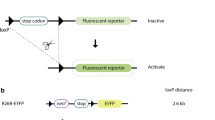Abstract
The analysis of mutants is an indispensable approach towards characterizing gene function. Combining several tools of Drosophila genetics, we designed a new strategy for a mutagenesis screen which is fast, easy-to-apply, and cheap. The combination of a cell-specific Gal4 line with an upstream activating sequence-green fluorescent protein (UAS-GFP) allows the in vivo detection of the cells or tissues of interest without the need for fixation and staining. To further simplify and accelerate the screening procedure, we generated recombinant flies that carry the Gal80 transgene in balancer chromosomes. Gal80 inactivates Gal4; and thus prevents GFP-expression during embryonic and postembryonic development in all individuals carrying the balancer chromosomes. This allows for an easy distinction in vivo between heterozygous and homozygous mutants, the latter being the only ones expressing GFP. Since most of the fly strains and balancer chromosomes can be substituted, this method is suitable for nearly any mutagenesis screen that does not have major restrictions.


Similar content being viewed by others
References
Barolo S, Carver LA, Posakony JW (2000) GFP and beta-galactosidase transformation vectors for promoter/enhancer analysis in Drosophila. Biotechniques 29:726, 728, 730, 732
Bellen HJ, O’Kane CJ, Wilson C, Grossniklaus U, Pearson RK, Gehring WJ (1989) P-element-mediated enhancer detection: a versatile method to study development in Drosophila. Genes Dev 3:1288–1300
Brand AH, Perrimon N (1993) Targeted gene expression as a means of altering cell fates and generating dominant phenotypes. Development 118:401–415
Campos-Ortega JA (1995) Genetic mechanisms of early neurogenesis in Drosophila melanogaster. Mol Neurobiol 10:75–89
Doe CQ (1992) Molecular markers for identified neuroblasts and ganglion mother cells in the Drosophila central nervous system. Development 116:855–863
Grigliatti T (1986) Mutagenesis. In: Roberts DB (Ed) Drosophila: a practical approach. IRL, Oxford, Washington DC, pp39–58
Hummel T, Schimmelpfeng K, Klämbt C (1997) Fast and efficient egg collection and antibody staining from large numbers of Drosophila strains. Dev Genes Evol 207:131–135
Ito K, Urban J, Technau GM (1995) Distribution, classification, and development of Drosophila glial cells in the late embryonic and early larval ventral nerve cord. Roux´s Arch Dev Biol 204:284–307
Kidwell MG (1986). P-M mutagenesis. In: Roberts DB (Ed) Drosophila: a practical approach. IRL, Oxford, Washington DC, pp59–82
Lee T, Luo L (1999) Mosaic analysis with a repressible cell marker for studies of gene function in neuronal morphogenesis. Neuron 22:451–461
Nüsslein-Volhard C, Wieschaus E (1980) Mutations affecting segment number and polarity in Drosophila. Nature 287:795–801
O’Donnell KH, Chen CT, Wensink PC (1994) Insulating DNA directs ubiquitous transcription of the Drosophila melanogaster alpha 1-tubulin gene. Mol Cell Biol 14:6398–6408
O’Kane CJ, Gehring WJ (1987) Detection in situ of genomic regulatory elements in Drosophila. Proc Natl Acad Sci USA 84:9123–9127
Robertson HM, Preston CR, Phillis RW, Johnson-Schlitz DM, Benz WK, Engels WR (1988) A stable genomic source of P element transposase in Drosophila melanogaster. Genetics 118:461–470
Suzuki DT, Procunier D (1969) Temperature-sensitive mutations in Drosophila melanogaster. 3. Dominant lethals and semilethals on chromosome 2. Proc Natl Acad Sci USA 62:369–376
Urbach R, Technau GM (2003) Molecular markers for identified neuroblasts in the developing brain of Drosophila. Development 130:3621–3637
Acknowledgements
We thank Erika Jost for her help in fly work, Ruth Beckervordersandforth and Rolf Urbach for their help in preparing the figures, and the Bloomington stock center for providing the fly strains. This work was supported by a grant from the Deutsche Forschungsgemeinschaft to B.A. and G.M.T.
Author information
Authors and Affiliations
Corresponding author
Additional information
Communicated by P. Simpson
Rights and permissions
About this article
Cite this article
Vef, O., Cleppien, D., Löffler, T. et al. A new strategy for efficient in vivo screening of mutagenized Drosophila embryos. Dev Genes Evol 216, 105–108 (2006). https://doi.org/10.1007/s00427-005-0036-5
Received:
Accepted:
Published:
Issue Date:
DOI: https://doi.org/10.1007/s00427-005-0036-5




